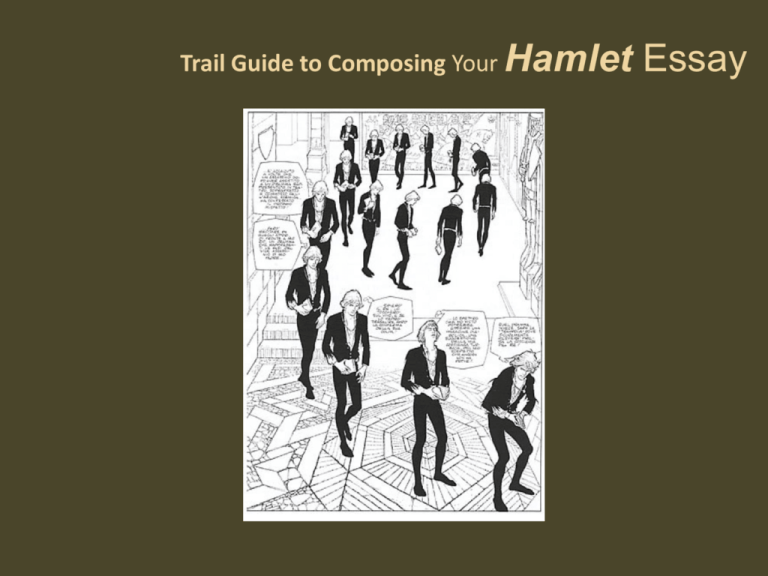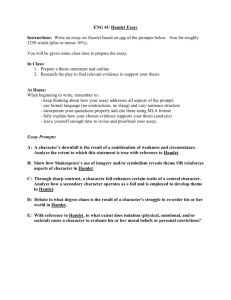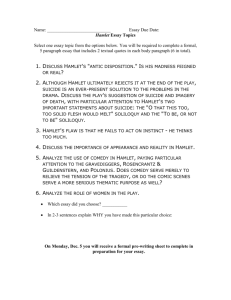Hamlet
advertisement

Trail Guide to Composing Your Hamlet Essay THE • Title Grabs the reader’s attention – the title is the gateway of your essay • Specifically states the topic of the essay, and a provocative idea or image (borrow words from Hamlet.) Let the reader know what is the literature under consideration. Exs.: Within the Compass of His Brain: Dutiful Hamlet A More Horrid Hent: The Vengeful Hamlet The Introductory Paragraph • Informs the reader of the author and title of the literature to be discussed. • Gives a brief background to the story, and what is the main character’s problematic situation. (A view of the “territory” of the essay.) • Ends with the thesis statement The Thesis Statement • Clearly states, in a single sentence, key points to be argued. • Stays close to the terms of the prompt. • Is concise, but complex enough to be interesting. Ex.: While Hamlet’s fury against his mother alone may be justified, his harsh treatment of Ophelia reflects an excessive, if not unnatural reaction to his mother’s betrayal. The Body of the Essay Key points from the thesis statement ________________________________________ serve as the claims of your body paragraphs. You may of course, for longer essays, write multiple paragraphs for each claim. Quotations from the text of the play must be followed by Act number. _____________ Scene number. ________________ Line number ______________ in parentheses: “O that this too, too sullied flesh would melt, / Thaw, and resolve itself into a dew” (1.2.133-134). Quotations from the critic must be followed by Last name, if not given in a tag line _________________________ and Page number, if known _________________________ in parentheses, followed by a period. Ex: Goethe sums up Hamlet’s problem as “a great action laid upon a soul unfit for the performance of it” (134). Remember to incorporate most quotations by paraphrasing part of the quote and directly quoting the remainder. Ex: Polonius attempts to convince the King and Queen that their “noble son is mad . . . nothing else but mad,” and urges them to “find out the cause” (2.2.95-103). The most engaging part of your essay is your commentary ___________________ on the literature. This is your place, not to paraphrase the story or summarize plot, but to EXCAVATE MEANINGS. Interpret and Explain: • How quoted data supports the claims of your thesis • How quoted data represents the writer’s intent • How literary devices you recognize in the quotation - tone, imagery, diction, allusions, symbolism – work in concert to further understanding of the subject of your thesis. Body Building Develop two or three body paragraphs (or sections of the essay), depending on the number of your claims. The claims and quotations are the bones, and your commentary is the MUSCLE of your essay! The Conclusion This is your grand finale! • Begin with a • Then restatement of your thesis. ____________ re-cap your argument, succinctly. • Finally, turn to your audience with an assertion of the “life lesson” in your topic, its universal significance. (Answer, “So what?”) Works Cited Means just this. Only (and all of) the works quoted in your essay. Refer to the following example of correct MLA style, but do NOT just copy and paste without adjusting the formats. Works Cited Clemen, W.H. “The Imagery of Hamlet.” 1951. Eliot, T.S. “Hamlet and His Problems.” Rpt. in Shakespeare, William. Hamlet. Ed. Cyrus Hoy. New York: W.W. Norton & Company, 1992. Gardner, Helen. “Hamlet and the Tragedy of Revenge.” 1959. Jones, Ernest. “Tragedy and the Mind of the Infant.” Rpt. in Shakespeare, William. Hamlet. Ed. Cyrus Hoy. New York: W.W. Norton & Company, 1992. Shakespeare, William. Hamlet. Ed. Cyrus Hoy. New York: W.W. Norton & Company, 1992.





